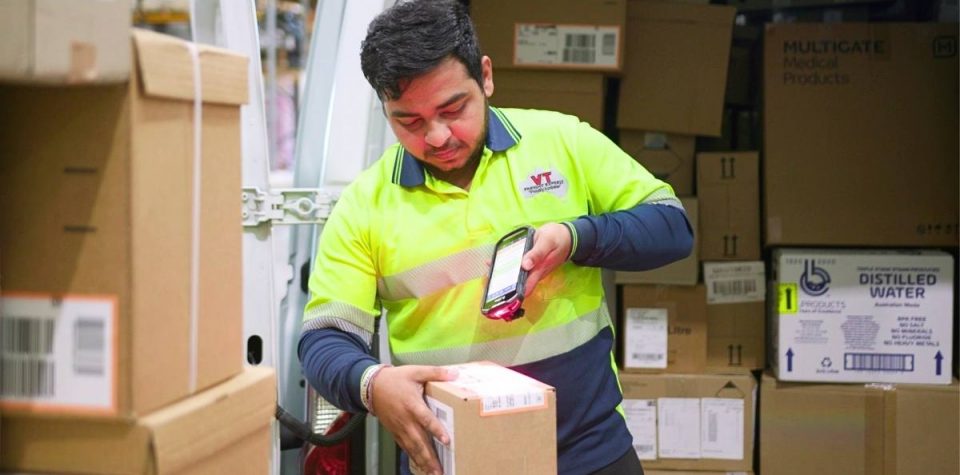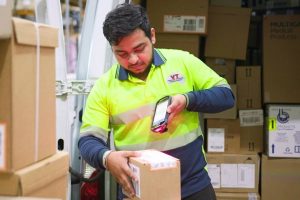Table of Contents:
- A Spark on the Sand: The Birth of the Barcode
- Crossing the Pacific: Barcodes Down Under
- The Magic Behind the Stripes: How Barcodes Work
- Logistics Lifeline: Barcodes in Parcel Delivery
- The Future is Coded: Beyond Scanners and Stripes
The humble barcode, those black and white stripes adorning everything from groceries to aeroplane boarding passes, is a ubiquitous marvel of innovation. But as you scan your groceries at the supermarket self-checkout, or deliver a package to a customer in deepest Footscray, have you ever wondered how these little striped marvels came about?
The story of barcodes is a remarkable journey, from a student’s brainstorm on a beach in Florida to its place as a cornerstone of Australian logistics. In this blog post, we are going to embark on a voyage through the barcode’s history, exploring its impact on the way we manage and move things Down Under, and use them to scan everything from a packet of lollies to a helicopter’s Jesus nut.
A Spark on the Sand: The Birth of the Barcode
Like all great inventions, the barcode came about almost by chance. In 1948, Norman Woodland, a young engineering student at Drexel University in the US, was strolling along a beach, idly drawing lines in the sand. Inspired by the dots and dashes of Morse Code, he envisioned a system of encoding information using similar patterns. This seemingly simple epiphany would mark the birth of the barcode.
“I just extended the dots and dashes [of Morse Code] downwards and made narrow lines and wide lines out of them,” Woodland explained in later years.
Woodland teamed up with his university friend Bernard Silver to develop the idea and together they patented their invention in 1952. However, the initial design – a bullseye-like pattern – proved impractical for the technology of the time. It wasn’t until the 1960s, with the advancements in scanners and lasers and, that the barcode truly began to take shape.
When the National Association of Food Chains (a former U.S. government department) heard about the idea in 1969, they formed the grandly-named U.S. Supermarket Ad Hoc Committee on a Uniform Grocery Product Code to perfect barcodes. Woodland played a key role in developing the most important version of the technology, the Universal Product Code (UPC), which soon became the standard for food packages.
The first item bearing a barcode that was ever scanned was a packet of chewing gum in an Ohio supermarket in 1974.
Crossing the Pacific: Barcodes Down Under
While the barcode’s origin story may have unfolded in the United States, its impact quickly transcended borders. Australia, with its geographically dispersed population and growing reliance on efficient logistics, embraced the technology early on.
One of the first major adopters was Coles Supermarkets, who implemented barcodes in their stores in the 1970s. This move revolutionised checkout processes by reducing errors and speeding up customer service. Soon, other retailers and industries followed suit, recognising the barcode’s potential to streamline their operations and boost productivity.
The Magic Behind the Stripes: How Barcodes Work
So, how do these seemingly simple black-and-white patterns pack such a punch? Barcodes are encoded data represented by varying widths and spacing of bars. A scanner reads these variations, translating them back into the encoded information.
Even a simple 8-line barcode can have 7^10 different combinations…that’s 282,475,249! So unless you have over two hundred and eighty million different items in your inventory, you’re never going to run out of barcode options
A code for every occasion
Different types of barcodes exist, each serving specific purposes.
- Bar Codes. The ubiquitous Universal Product Code (UPC) is the one that you’ll see on groceries. That packet of TimTams, bag of Smiths chips, bottle of Rosella tomato sauce and box of VB that you chuck into your shopping cart on the way to the beach all have a unique barcode on them. These encode product details like manufacturer and item number along with price and expiry date.
- QR codes. Those square patterns often seen on poster advertisements, TV screens and electronic products can store much more information, including website addresses or entire documents such as operating instructions.
While still not as ubiquitous as barcodes, QR codes are now popping up all over the place – thanks to some of the best QR code generator available in the market. Your beer glass down at the RSL, for example, might have a QR code that lets you access competitions. You can also scan QR codes to access and order from restaurant menus, find out when the next bus to Cabramatta is coming along, or get your Lime scooter going if you miss it.
Mobile Scanning: Power in Your Pocket
The rise of smartphones has ushered in a new era of barcode interaction. Mobile barcode-scanning apps empower consumers to access instant product information, compare prices, and even make purchases directly from their phones. This has significantly impacted consumer behaviour and retail strategies alike.
In Australia, companies like Woolworths and Big W have incorporated mobile scanning into their loyalty programs, allowing customers to quickly self-scan groceries and earn rewards. This enhances convenience and reduces checkout lines, contributing to a smoother shopping experience.
Logistics Lifeline: Barcodes in Parcel Delivery
Perhaps the most crucial role of barcodes (for regular readers of this blog, at least) lies in the realm of logistics and parcel delivery. Imagine trying to track millions of packages traversing vast distances across Australia and worldwide without barcodes. It would be pure bloody chaos, wouldn’t it?
Track, trace, sort and deliver
Barcodes act as unique identifiers, enabling seamless tracking and sorting of parcels throughout their journey. From warehouse shelves to delivery trucks, scanners ensure accurate and efficient delivery, minimising errors and delays.
In Australia, major postal and courier services like Australia Post, DHL, and TNT heavily rely on barcode technology. This ensures timely and reliable deliveries, a vital cog in the nation’s e-commerce boom. It also allows logistics companies to track their deliveries from pickup to hand-over, making it much easier to find items if they are misdirected or lost.
The Future is Coded: Beyond Scanners and Stripes
These days, barcodes seem to be almost everywhere: from cattle ear tags to baggage carousels. But we are yet to see their full potential. Advancements in near-field communication (NFC) technologies are paving the way for contactless scanning, further streamlining interactions and data exchange. Additionally, the integration of barcodes with online payment technology holds immense potential for enhancing supply chain transparency and traceability.
In Australia, research and development efforts are exploring innovative applications of barcodes in diverse fields, from tracking grain and seed crops in agriculture to managing medical supplies in hospitals. The possibilities seem endless, driven by the barcode’s inherent versatility and ever-evolving technology.
From a beachside brainstorm to a logistics lifeline, the barcode’s journey in Australia is a testament to the boundless potential that technology has to transform the way we live, shop, and move things. At TransVirtual, we love technology. And we specialise in creating logistics software that can seamlessly interact with all of your digital systems, including barcodes.
So as we embrace the future, one scan at a time, the legacy of Norman Woodward’s lines in the sand will continue to shape the world around us, ensuring a smoother, more efficient, and interconnected Australia.



